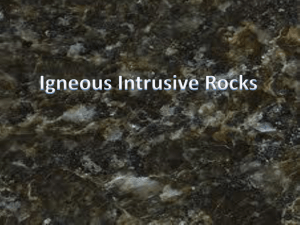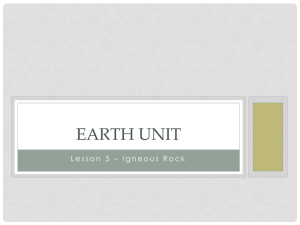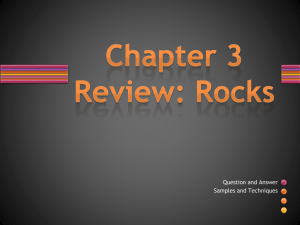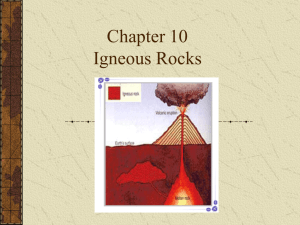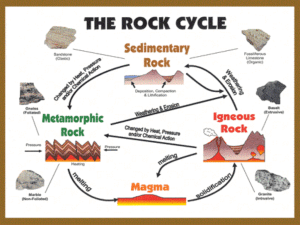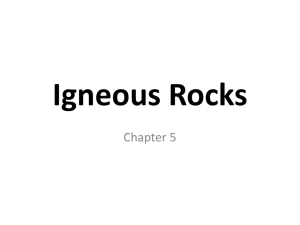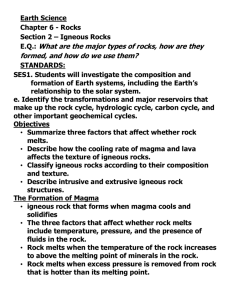Chapter 6: Igneous Rocks
advertisement
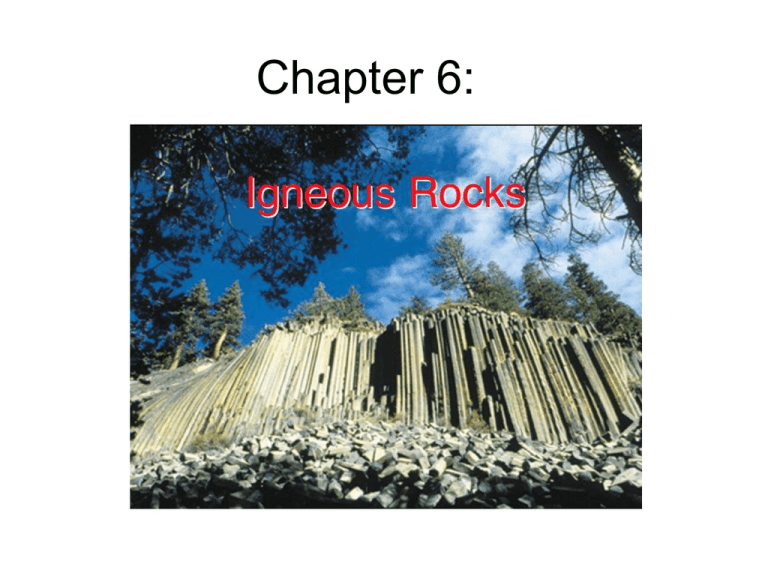
Chapter 6: What are igneous rocks? • Igneous rocks gets its name from the Latin word for “fire”, because it is formed from hot molten rock (magma) inside the Earth. When the molten rock solidifies, it forms solid igneous rock. • The way the magma cools determines the kind of igneous rock that is formed. • Magma is molten rock, while lava is magma on the Earth’s surface. • Igneous rocks may be either extrusive if they form at the surface (ex. basalt) or intrusive if magma solidifies underground (ex. granite). Watch Video From Minerals to Rocks… Igneous Rock Textures • Texture refers to a rock’s appearance with respect to the size, shape and arrangement of its grains. • Extrusive rocks are typically fine-grained (grains smaller than 1mm). The grains are small because the magma cooled rapidly at the surface, and large crystals did not have time to form. Some intrusive rocks are fine grained, but these would have formed near the surface in “cold rock”. Extrusive rock called obsidian. This is a glasslike rock that forms at the surface Igneous Rock Textures • Intrusive rocks usually form at considerable depth (more than a few km) and are called plutonic rocks (after Pluto, the Roman god of the underworld). • Intrusive rocks are typically coarse-grained (bigger than 1mm) because of the slow cooling and solidification of magma How are igneous rocks classified? • Igneous rocks names are based on texture (basically grain-size) and mineral composition. • So, each type of igneous rock will have: 1. a specific combination of minerals. 2. coarse or fine grains. Plutonic rocks are easier to identify because of the larger crystals. Common Igneous Rocks Group 1 Granite Rhyolite •Formed inside Earth •Formed at surface •Coarse-grained •Fine-grained •Quartz crystals visible •Crystals too small •Feldspars •Feldspars Common Igneous Rocks Group 2 Diorite Andesite •Formed inside Earth •Formed at surface •Coarse-grained •Fine-grained •No quartz •Crystals too small to see •Feldspars; 30-50% ferromagnesian minerals •Feldspars; 30-50% ferromagnesian minerals Common Igneous Rocks Group 3 Gabbro Basalt •Formed inside Earth •Formed at surface •Coarse-grained •Fine-grained •Mostly ferromagnesian minerals •Mostly ferromagnesian minerals • Some feldspars • Some feldspars Identification of Igneous Rocks Coarse – Grained (slow cool) Fine Grained (fast cool) Mineral Content Granite Diorite Gabbro Peridotite Rhyolite Andesite Basalt -- Quartz & feldspars Feldspars & Mostly Entirely ferromagnesian ferromagnesian ferromagnesian minerals; no quartz minerals minerals Colour LightMedium grey or coloured med.-green (white, light grey or pink) Dark grey to black Green to black Occurrences of Igneous Rock Rock Type Occurence Occurrence Basalt & gabbro Oceanic crust at divergent boundaries Andesite & diorite Granite & rhyolite Convergent plate boundaries (ex. Volcanoes) Continental crust at convergent boundaries & over mantle plumes What happens when magma cools underground? • Cooling magma may form intrusive structures, or bodies of magma that crystallize/harden after flooding surrounding rock layers Examples of Intrusive Structures 1.Volcanic neck (magma is solidified in the neck of a volcano) 2.Dike & Sills (magma solidifies into a wall after being squeezed through two rock layers) Ex. Ship Rock in New Mexico, USA Shiprock, New Mexico Volcanic neck Shiprock Video (4:20 mark) Dike Dikes & Sills Examples of Intrusive Structures (cont’d) • Plutons are blobs of magma that crystallize within the crust. If these plutons make it to the surface, large areas of rock (usually granite) form huge outcrops of rock at the surface. Batholiths are areas of plutons greater than 100km2. Batholiths are present in the Sierra Nevada Mountains of California and in the Appalachian Mountains Halifax Pluton, South Mountain Batholith, Nova Scotia Batholith Formation Examples of Extrusive Structures • The most obvious structures made of extrusive igneous rock (or igneous rock at the surface) are:

